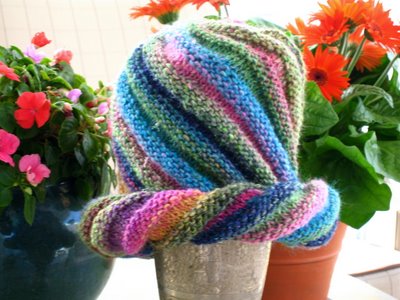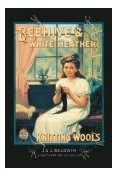
Pattern
The classic based on Plymouth Yarn's but modified by moi. I use #8 needles because I knit somewhat loosely. Using a provisional cast-on, cast on 72 sts. Pattern is two-fold, horizontally at each end of rows and vertically as the wide ribbing ridges are knit. It's a kind of magic knitting trick which makes a lovely, turban-like hat. Even experienced knitters wonder how it's made. Use yarn that stripes with long repeats of color to take advantage of the striping effect. Or else, adjust the ribbing to fit the colorway. The style flatters a wide variety of heads!
Pattern in Short: On every other row slip 1, k2tog at beginning of row; continue to last 2 sts; make 1 stitch in next st then k or purl last st. At the same time, make as many wide rib ridges of 4 rows stockingette and 4 rows reverse stockingette as needed to fit head. This hat used 15 complete ridges; it also used up all the yarn -- every inch of two skeins. The cast-on row will form the last row of a complete 8-row ridge.
Wide rib pattern: [*Knit the, next row, Purl next row* 2 times; *purl 1 row, knit 1 row* 2 times]. End with 2 rows matching the cast-on row; the 3rd row will be joined by the kitchener stitch row to the cast on row. Warning: make sure there's enough yarn to knit the required number of complete ridges. To end, pick up the 72 sts from provisional cast on and kitchener st together with the last row. The trapezoidal shape is what makes the lovely diagonal stripes when the cast on edge is joined to the last row of live sts.
Top of hat: After kitchener stitching the edges, you will have a tube. Then pull yarn through stitches at whichever end best fits the intended head. I add a short length of strong fingering weight yarn at this point because the Noro just isn't strong enough to pull through tightly without breaking. This hat can be reversible but I usually do a little extra stitching on the side that has been designated the reverse side so that there isn't a hole where 60 sts (8 rows times 15 divided by 2 because I slip the first st) are pulled together. I usually pull the yarn through the end that was the "make one stitch" edge because it's curved and adds a little extra to the turban look. Turning over the edge reveals the contrasting color patterns on the reveres side which is always somewhat different because of the effects of using a ribbing pattern.
Questions: (I wish I'd photographed this phenomenon and will next time): why is the "k2tog: edge straight and the "Make one" edge curved? It works out but it's what's kept me from making a clapotis.
Noro controversy adddressed
I had one knot in 2 skeins which was very loosely tied. I was able to take out the knot and join the yarn as I normally would when beginning a new skein. No sticks or straw in this yarn -- more common in the Kureyon in my experience. Is Noro worth it? I try to get it on sale but I still think the spectacular colorways well worth it, especially for knitted presents. I also rather like that the colors are spun, not space dyed -- it appeals to my old hippie-wannabe self.

1 comment:
Neat hat, Liza. Lucky is the friend who gets it! Thanks for your tips. Looking forward to seeing your personally dyed Soysilk spun up.
Post a Comment